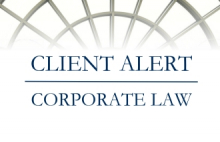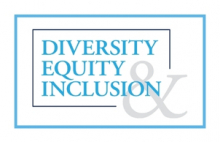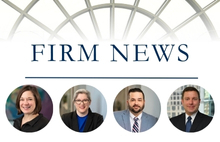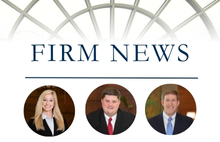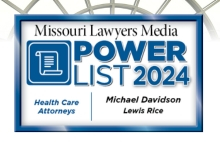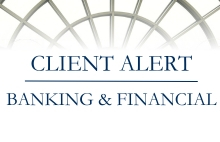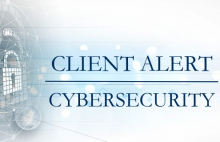SBA Paycheck Protection Program Rule Issued: What Borrowers Need to Know
April 3, 2020On April 2, 2020, the U.S. Small Business Administration (SBA) issued an interim final rule (the “Interim Final Rule”) relating to the new Paycheck Protection Program (PPP) added to the SBA 7(a) Loan Program under the Coronavirus Aid, Relief, and Economic Security Act (CARES Act) signed by President Trump on March 27, 2020. The CARES Act provides emergency assistance and health care response for individuals, families, and businesses affected by the COVID-19 pandemic. Loans covered under the PPP will also be 100% guaranteed by SBA, and the full principal amount of the loans may qualify for loan forgiveness. The Interim Final Rule provides formal guidance to businesses interested in obtaining a loan under the PPP and to lenders that are interested in making loans under the PPP. For reference, please see our prior alerts relating to the PPP here and here.
Given the need to provide guidance to businesses, self-employed individuals, non-profit organizations, and independent contractors who are looking to apply for a loan, and in light of the Trump Administration’s statements that applications for loans under the PPP will be accepted starting on April 3, 2020 for small businesses and sole proprietors, and on April 10, 2020 for independent contractors and self-employed individuals, the Interim Final Rule was issued without advance notice and public comment as authorized by Section 1114 of the CARES Act. The Interim Final Rule solicits comments from interested members of the public on all aspects of the Interim Final Rule. Comments from the public must be received on or before 30 days after publication of the Interim Final Rule in the Federal Register, so it is possible that the Interim Final Rule may be modified in the future. In addition, as noted below, we expect that additional rules regarding the PPP will be issued in the future.
This alert summarizes matters of particular relevance to borrowers interested in applying for a loan under the PPP. While much of this discussion will be relevant to lenders, we will also be providing a summary of matters in the Interim Final Rule that are particularly relevant to lenders.
Eligibility
Eligible Entities and Individuals
As stated in the Interim Final Rule:
- “You are eligible for a PPP loan if you have 500 or fewer employees whose principal place of residence is in the United States, or are a business that operates in a certain industry and meet the applicable SBA employee-based size standards for that industry, and:
i. You are:
a. A small business concern as defined in section 3 of the Small Business Act (15 USC 632), and subject to SBA’s affiliation rules under 13 CFR 121.301(f) unless specifically waived in the CARES Act;
b. A tax-exempt nonprofit organization described in section 501(c)(3) of the Internal Revenue Code (IRC), a tax-exempt veterans organization described in section 501(c)(19) of the IRC, Tribal business concern described in section 31(b)(2)(C) of the Small Business Act, or any other business; and
ii. You were in operation on February 15, 2020 and either had employees for whom you paid salaries and payroll taxes or paid independent contractors, as reported on a Form 1099-MISC.”
- “You are also eligible for a PPP loan if you are an individual who operates under a sole proprietorship or as an independent contractor or eligible self-employed individual, and you were in operation on February 15, 2020.”
- “You must also submit such documentation as is necessary to establish eligibility such as payroll processor records, payroll tax filings, or Form 1099-MISC, or income and expenses from a sole proprietorship. For borrowers that do not have any such documentation, the borrower must provide other supporting documentation, such as bank records, sufficient to demonstrate the qualifying payroll amount.”
Ineligible Entities and Individuals
The following entities and individuals (among others) would be ineligible to receive a PPP loan:
- those engaged in any activity that is illegal under federal, state, or local law;
- household employers (that is, individuals who employ household employees such as nannies or housekeepers);
- owners of 20% or more of the equity of the applicant that are incarcerated, on probation, on parole;
- those that are presently subject to an indictment, criminal information, arraignment, or other means by which formal criminal charges are brought in any jurisdiction; or those that have been convicted of a felony within the last five years; and
- those who have (or whose business owned or controlled by them or any of their respective owners) ever obtained a direct or guaranteed loan from SBA or any other Federal agency that is currently delinquent or has defaulted within the last 7 years and caused a loss to the government.
Additional businesses that are ineligible for PPP loans are identified in 13 CFR 120.110 and described further in SBA’s Standard Operating Procedure (SOP) 50 10, Subpart B, Chapter 2. Nonprofit organizations authorized under the Act are eligible. These ineligible entities include, among others and with some limited exceptions:
- financial businesses primarily engaged in the business of lending, such as banks, finance companies, and factors;
- passive businesses owned by developers and landlords that do not actively use or occupy the assets acquired or improved with the loan proceeds;
- life insurance companies;
- businesses located in a foreign country;
- businesses deriving more than one-third of gross annual revenue from legal gambling activities;
- businesses engaged in any illegal activity, including marijuana-related or cannabis-related businesses;
- private clubs and businesses which limit the number of memberships for reasons other than capacity;
- businesses principally engaged in teaching, instructing, counseling, or indoctrinating religion or religious beliefs, whether in a religious or secular setting;
- businesses with an associate who is incarcerated, on probation, on parole, or has been indicted for a felony or a crime of moral turpitude;
- businesses which: (i) present live performances of a prurient sexual nature; or (ii) derive directly or indirectly more than de minimis gross revenue through the sale of products or services, or the presentation of any depictions or displays, of a prurient sexual nature;
- unless waived by SBA for good cause, businesses that have previously defaulted on a Federal loan or Federally assisted financing, resulting in the Federal government or any of its agencies or Departments sustaining a loss in any of its programs, and businesses owned or controlled by an applicant or any of its associates which previously owned, operated, or controlled a business which defaulted on a Federal loan (or guaranteed a loan which was defaulted) and caused the Federal government or any of its agencies or Departments to sustain a loss in any of its programs;
- businesses primarily engaged in political or lobbying activities; and
- speculative businesses (such as oil wildcatting; dealing in stocks, bonds, commodity futures, and other financial instruments; mining gold or silver in other than established fields; research and development; and building homes for future sale (except under the Builders CAPLines program)).
Affiliation Rules and Applicant Identity
The Interim Final Rule states that SBA intends to promptly issue additional guidance with regard to the applicability of affiliation rules at 13 CFR §§ 121.103 and 121.301 to PPP loans.
We have received many inquiries asking whether the applicant for a loan under the PPP must be the actual employer who is responsible for payment of the payroll costs to employees, or whether, in the case of an applicant and its affiliates as determined under the affiliation rules, there can be a joint application by a parent entity (in lieu of having to obtain separate PPP loans for each entity). The Interim Final Rule does not address this issue.
Maximum Loan Amount Calculation
Sample Calculation
The Interim Final Rule provides a helpful methodology for calculating the maximum loan amount that an applicant can borrow, as well as sample calculations.
Step 1: Aggregate payroll costs from the last 12 months for employees whose principal place of residence is the United States.
Step 2: Subtract any compensation paid to an employee in excess of an annual salary of $100,000 and/or any amounts paid to an independent contractor or sole proprietor in excess of $100,000 per year.
Step 3: Calculate average monthly payroll costs (divide the amount from Step 2 by 12).
Step 4: Multiply the average monthly payroll costs from Step 3 by 2.5.
Step 5: Add the outstanding amount of an Economic Injury Disaster Loan (EIDL) made between January 31, 2020 and April 3, 2020, less the amount of any “advance” under an EIDL COVID-19 loan (because it does not have to be repaid).
What qualifies as “payroll costs”?
Many of the questions that we have received relating to the PPP deal with the definition of “payroll costs,” as applicants need to know what they can and cannot include for purposes of determining the maximum loan amount and, ultimately, the amount that may be forgiven.
The Interim Final Rule states that the term “payroll costs”:
- consist of the following:
- compensation to employees (whose principal place of residence is the United States) in the form of salary, wages, commissions, or similar compensation;
- cash tips or the equivalent (based on employer records of past tips or, in the absence of such records, a reasonable, good-faith employer estimate of such tips) (this is particularly notable for restaurants);
- payment for vacation, parental, family, medical, or sick leave;
- allowance for separation or dismissal;
- payment for the provision of employee benefits consisting of group health care coverage, including insurance premiums, and retirement;
- payment of state and local taxes assessed on compensation of employees; and
- for an independent contractor or sole proprietor, wage, commissions, income, or net earnings from self-employment or similar compensation;
- but exclude the following:
- any compensation of an employee whose principal place of residence is outside of the United States;
- the compensation of an individual employee in excess of an annual salary of $100,000, prorated as necessary;
- federal employment taxes imposed or withheld between February 15, 2020 and June 30, 2020, including the employee’s and employer’s share of FICA (Federal Insurance Contributions Act) and Railroad Retirement Act taxes, and income taxes required to be withheld from employees; and
- qualified sick and family leave wages for which a credit is allowed under sections 7001 and 7003 of the Families First Coronavirus Response Act (Public Law 116–127).
Independent Contractors
The Interim Final Rule provides (or perhaps more accurately, attempts to provide) clarification on the treatment of independent contractors for purposes of the PPP. In a question and answer format, the Interim Final Rule addresses independent contractors as follows:
- “Do independent contractors count as employees for purposes of PPP loan calculations? No, independent contractors have the ability to apply for a PPP loan on their own so they do not count for purposes of a borrower’s PPP loan calculation.”
- “Do independent contractors count as employees for purposes of PPP loan forgiveness? No, independent contractors have the ability to apply for a PPP loan on their own so they do not count for purposes of a borrower’s PPP loan forgiveness.”
The Interim Final Rule makes it clear that independent contractors should not be included in calculating total employees for purposes of determining the maximum loan amount or for determining the amount of loan forgiveness. While the Interim Final Rule indicates that applicants should deliver evidence that they have paid independent contractors, and addresses amounts paid to independent contractors in the methodology for calculation of the maximum loan amount in the Interim Final Rule (which methodology the Interim Final Rule states “will be most useful for many applicants”), the Interim Final Rule also states that “independent contractors have the ability to apply for a PPP loan on their own so they do not count for purposes of a borrower’s PPP loan calculation.” Based on the foregoing, we believe that applicants should exclude payments to independent contractors in payroll costs for all purposes under the PPP.
Permitted and Required Uses of PPP Loan Proceeds
Permitted and Required Uses
The Interim Final Rule states that proceeds of a PPP loan are to be used for the following items:
- payroll costs (as defined in the CARES Act and as further clarified in section 2.f. of the Interim Final Rule);
- costs related to the continuation of group health care benefits during periods of paid sick, medical, or family leave, and insurance premiums;
- mortgage interest payments (but not mortgage prepayments or principal payments);
- rent payments;
- utility payments;
- interest payments on any other debt obligations that were incurred before February 15, 2020; and/or
- refinancing an EIDL made between January 31, 2020 and April 3, 2020.
Importantly, the Interim Final Rule requires that each borrower use at least 75% of the PPP loan proceeds for payroll costs (which will include the amount of any EIDL refinanced). While the other uses outlined above remain permitted, the Interim Final Rule explains “that the finite appropriations and the structure of the Act warrant a requirement that borrowers use a substantial portion of the loan proceeds for payroll costs, consistent with Congress’ overarching goal of keeping workers paid and employed.”
Misuse of PPP Loan Proceeds
The Interim Final Rule notes that if a borrower misuses PPP loan proceeds:
- SBA will direct the borrower to repay those amounts;
- if the borrower knowingly uses PPP funds for unauthorized purposes, the borrower will be subject to additional liability, such as charges for fraud; and
- if one of the borrower’s owners uses PPP funds for unauthorized purposes, SBA will have recourse against such owner for unauthorized use.
Applicants with Economic Injury Disaster Loans
The Interim Final Rule confirms that an applicant that received an EIDL (discussed in our prior alert here) between January 31, 2020 and April 3, 2020 can still apply for a PPP loan. If the EIDL was not used for payroll costs, it does not affect the applicant’s eligibility for a PPP loan. However, if the EIDL was used for payroll costs, the applicant must use the PPP loan to refinance the EIDL. Proceeds from any advance up to $10,000 on the EIDL will be deducted from the loan forgiveness amount on the PPP loan.
Loan Forgiveness
Up to the full principal amount of the PPP loan and any accrued interest may be forgiven. As explained in the Interim Final Rule, “the borrower will not be responsible for any loan payment if the borrower uses all of the loan proceeds for forgiveable (sic) purposes described below and employee and compensation levels levels (sic) are maintained.”
The actual amount of loan forgiveness will depend, in part, on the amount of the following out-of-pocket costs and payments made over the eight-week period following the date of origination of the PPP loan:
- the total amount of payroll costs;
- payments of interest on mortgage obligations incurred before February 15, 2020;
- rent payments on leases dated before February 15, 2020; and
- utility payments under service agreements dated before February 15, 2020.
The Interim Final Rule confirms an important limitation, first indicated in the initial guidance issued by the U.S. Department of Treasury, that no more than 25% of the loan forgiveness amount may be attributable to non-payroll costs. Stated another way, mortgage interest, rent, and utility payments cannot constitute more than 25% of the loan forgiveness amount, thereby ensuring that at least 75% of the forgiven amount was used to pay payroll costs. The Interim Final Rule states that SBA determined in consultation with the Secretary of the Treasury that 75% is an appropriate percentage in light of the CARES Act’s overarching focus on keeping workers paid and employed. The Interim Final Rule clarifies that the amount of any EIDL refinanced will be included for purposes of determining the percentage of use of proceeds for payroll costs.
Notably, the Interim Final Rule does not address reductions to the forgiveness amount due to reductions in full-time equivalent employees or reductions in wages and salary, which were discussed in our prior alert here. According to the Interim Final Rule, SBA will issue additional guidance on loan forgiveness.
Loan Terms
- Interest Rate. All PPP loans will be 1% per year. This is a change from the initial guidance issued by the U.S. Department of Treasury, discussed in our prior alert here, which stated the applicable interest rate would be 0.5% per year.
- Maturity Date. All PPP loans will mature two years following the incurrence of the loan.
- Repayment. Borrowers will not have to make any payments (principal or interest) for six months following the date of disbursement of the PPP loan. However, interest will accrue during the deferment period.
- No collateral or guarantees are required. As a result of the CARES Act, these requirements are waived.
Application Process
Application Materials
Applicants must submit the following:
- SBA Form 2483 (Paycheck Protection Program Borrower Application Form); and
- payroll documentation, as described in the Interim Final Rule, such as payroll processor records and payroll tax filings.
Certification
A newly-updated SBA Form 2483 (Paycheck Protection Program Borrower Application Form) was posted to the Department of Treasury’s website late in the day on April 2, 2020. The newly-posted application no longer requires the signature or acknowledgment of owners of greater than 20% of the applicant. The Interim Final Rule states that a representative of the applicant can certify for the business as a whole if the representative is legally authorized to do so. The applicant must certify in good faith to all of the below (note there are some minor differences from the language of the Interim Final Rule):
- “The Applicant was in operation on February 15, 2020 and had employees for whom it paid salaries and payroll taxes or paid independent contractors, as reported on Form(s) 1099-MISC.”
- “Current economic uncertainty makes this loan request necessary to support the ongoing operations of the Applicant.”
- “The funds will be used to retain workers and maintain payroll or make mortgage interest payments, lease payments, and utility payments, as specified under the Paycheck Protection Program Rule; I understand that if the funds are knowingly used for unauthorized purposes, the federal government may hold me legally liable, such as for charges of fraud.”
- “The Applicant will provide to the Lender documentation verifying the number of full-time equivalent employees on the Applicant’s payroll as well as the dollar amounts of payroll costs, covered mortgage interest payments, covered rent payments, and covered utilities for the eight-week period following this loan.”
- “I understand that loan forgiveness will be provided for the sum of documented payroll costs, covered mortgage interest payments, covered rent payments, and covered utilities, and not more than 25% of the forgiven amount may be for non-payroll costs.”
- “During the period beginning on February 15, 2020 and ending on December 31, 2020, the Applicant has not and will not receive another loan under the Paycheck Protection Program.”
- “I further certify that the information provided in this application and the information provided in all supporting documents and forms is true and accurate in all material respects. I understand that knowingly making a false statement to obtain a guaranteed loan from SBA is punishable under the law, including under 18 USC 1001 and 3571 by imprisonment of not more than five years and/or a fine of up to $250,000; under 15 USC 645 by imprisonment of not more than two years and/or a fine of not more than $5,000; and, if submitted to a federally insured institution, under 18 USC 1014 by imprisonment of not more than thirty years and/or a fine of not more than $1,000,000.”
- “I acknowledge that the lender will confirm the eligible loan amount using required documents submitted. I understand, acknowledge and agree that the Lender can share any tax information that I have provided with SBA's authorized representatives, including authorized representatives of the SBA Office of Inspector General, for the purpose of compliance with SBA Loan Program Requirements and all SBA reviews.”
The certification that “[c]urrent economic uncertainty makes this loan request necessary to support the ongoing operations of the applicant” has been the subject of many questions and requests for clarification that we have received. Unfortunately, to date, we are not aware that there has been any formal guidance issued that would shed light on its meaning.
Conclusion
Interested businesses should reach out to their lenders and banking relationships now to start the application process. Although the purpose of the CARES Act and the PPP created thereunder are straight-forward, the details, application, and implementation thereof has not been. The issues facing applicants and lenders in obtaining and making, respectively, loans under the PPP are complex. While the Interim Final Rule does clarify some issues, we believe additional guidance, which is forthcoming, will be necessary. Lewis Rice will continue to monitor these developments and provide updates as needed.
To stay abreast of the emerging legal issues raised by the coronavirus pandemic, Lewis Rice has formed a COVID-19 Task Force, which brings together subject matter authorities from various practice areas within the Firm who stand ready to assist our clients as they navigate these complex challenges. Our attorneys are closely monitoring these developments as they occur and will make regular updates to our COVID-19 Resource Center. If you have any questions about the federal government programs available, or the implications and disruptions of COVID-19 on your business, please reach out to one of the authors above or another member of the Task Force.
